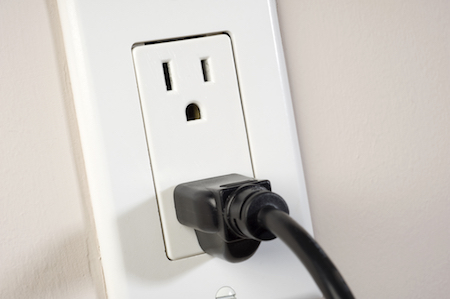How Far Apart Should Home Electrical Outlets Be?
Have you ever wished for a home electrical outlet somewhere else in a room? Have you ever stopped to wonder why the builder installed an electrical outlet in one place and not another?
There’s a reason for that. The US National Electrical Code, Section 210.52, states that there should be an electrical outlet in every kitchen, bedroom, living room, family room, and any other room that has dedicated living space. They must be positioned at least every twelve feet measured along the floor line. These do not include dedicated electrical outlets for items like your stove, or receptacles included in cabinets or drawers, located more than 5 ½ feet off the floor, or controlled by a light switch.
 It goes into further detail based on each room. For example, in the kitchen, countertop outlets should be no further than 48 inches apart. This is because that’s the average length of an electrical cord found on all modern day appliances. If you don’t have to overstretch to use an appliance, there’s less risk of hazard.
It goes into further detail based on each room. For example, in the kitchen, countertop outlets should be no further than 48 inches apart. This is because that’s the average length of an electrical cord found on all modern day appliances. If you don’t have to overstretch to use an appliance, there’s less risk of hazard.
The US NEC also advises on type. Two 20-amp circuits for kitchen receptacles, one for the laundry, one for each bathroom, and one separate branch for central heating and air conditioning equipment. These are for high-powered appliances, like your hair dryer.
General areas like living and family rooms don’t have requirements for ground fault current interrupter (GFCI) outlets. GFCI must be installed in bathrooms, and be at least within three feet of the outside edge of the sink. GFCI outlets are also required for all countertop receptacles in the kitchen.
As an additional safety measure, tamper-resistant outlets are now being required on many new builds. You’ll find these outlets identified by recessed “TR” on the face of the outlet. Tamper-resistant outlets have a spring loaded gate within the outlet itself to prevent young children from being able to shove objects into it. They typically aren’t required if an outlet is located 66 inches or more off the floor, if it’s located behind a large appliance, or if it’s part of a light fixture or other device.
Of course, guidelines are created to provide minimums. Many homes today do better when they offer the homeowner more access to electricity in different parts of the house.
If you’ve ever wished for an outlet, repeatedly run out of space to plug in today’s most popular smart devices, or wondered if your home still supports your electrical demands, it’s time to talk with one of our electricians. We can help you update your wiring and install home electrical outlets to meet your needs.





